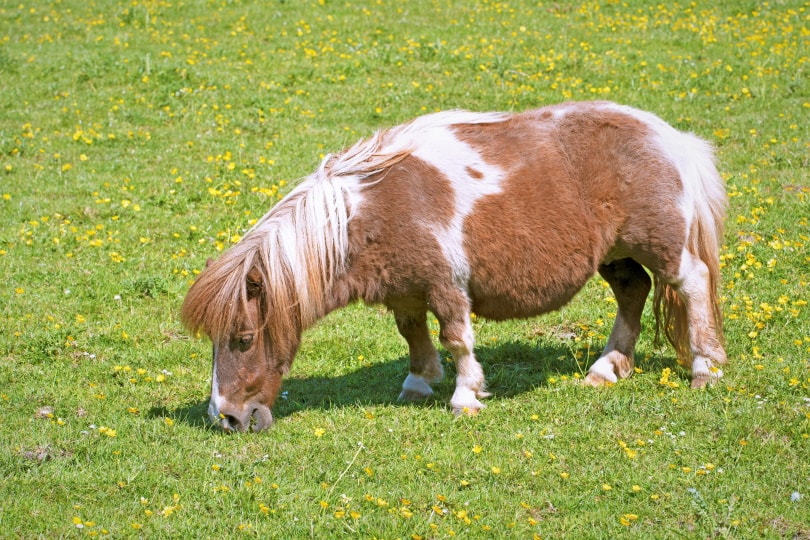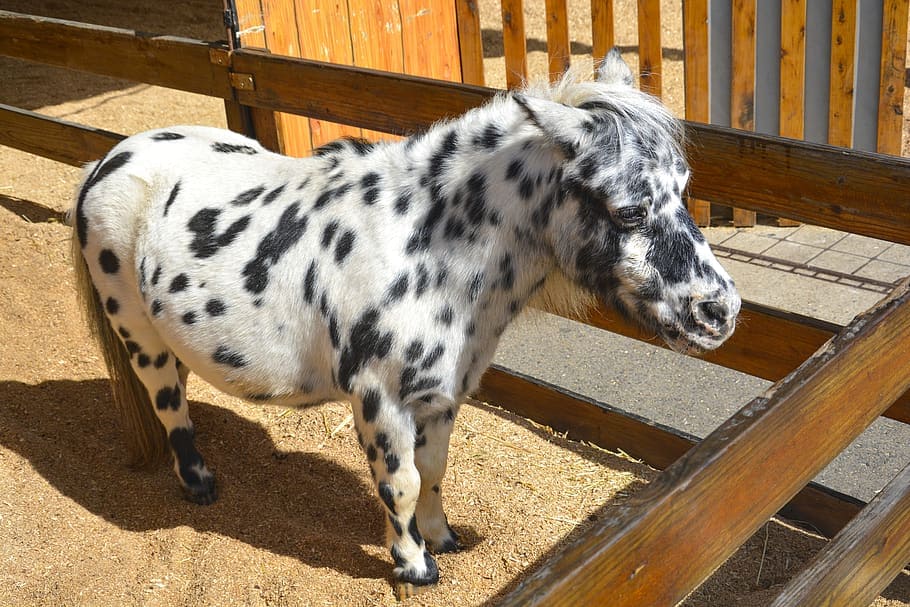
Click to Skip Ahead
Miniature Horses, with their adorable appearance and compact size, have captured the hearts of many animal lovers worldwide. These pint-sized equines are delightful companions, possessing remarkable traits and characteristics. If you are thinking about getting one but want to know more about them first, keep reading as we discuss their origins, appearance, and habitat to help you make an informed purchase.
| Care Level: | Moderate |
| Temperature: | All climates |
| Temperament: | Friendly, intelligent, curious, playful |
| Colors: | Bay, chestnut, black, gray |
| Lifespan: | 25–30 years |
| Weight: | 150–350 pounds (stallions), 150–350 pounds (mares) |
| Height: | < 9 hands (stallions), < 9 hands (mares) |
Miniature Horses usually have a gentle and friendly temperament, and owners often describe them as intelligent, curious, and sociable animals. Their calm and docile nature makes them suitable for interactions with people of all ages, including children, and they can form strong bonds with their human caretakers. They have a relatively long lifespan compared to most other horse breeds; with proper care and nutrition, they can live well into their 30s, with some living into their 40s.
Miniature Horse Characteristics
What Are These Horses Used For?
Despite their small size, Miniature Horses exhibit impressive versatility. You can train them for various activities, such as driving, showing, and even agility courses, and their adaptability makes them suitable for different environments, including suburban settings, hobby farms, and therapeutic settings. They make great companion animals and can even help people with disabilities and special needs.

Where Did These Horses Originate From?
The origins of Miniature Horses can be traced back to ancient times, with evidence of small equines found in ancient Egypt and Rome. However, during the 17th century in Europe, breeding programs specifically aimed at producing small horses began. In the Netherlands and Germany, breeders used selective breeding to create small horses to serve as royal pets, status symbols, and working animals. During the 19th century, these small horses came to the United States to work in circuses and fairs as novelty attractions. In 1978, the American Miniature Horse Association was founded in the United States, setting breed standards and promoting the breeding and showing of Miniature Horses.
Temperament & Intelligence of the Miniature Horse
Miniature Horses have a friendly and gentle temperament. They are often sociable, enjoy human interaction, and are easy to handle. Many are also calm and docile, making them well-suited for companionship and therapy work. However, as with any horse, individual temperament can vary, and some Miniature Horses may have more spirited or independent personalities, making them less universally friendly.
They are quick learners and can understand and respond well to training. They have good problem-solving abilities and can adapt to new situations. With proper training and positive reinforcement methods, Miniature Horses can excel in various tasks, such as driving, obstacle courses, and other equine activities, making them ideal for events and competitions.
Appearance & Varieties
Miniature Horses are significantly smaller than regular horses and often resemble scaled-down versions of larger horse breeds. They exhibit the same basic body structure, with a well-arched neck, defined withers, compact body, and a sturdy stance, but they stand less than 34 inches tall at the withers. Miniature Horses can come in various coat colors and patterns like their larger counterparts, and common ones include bay, black, chestnut, gray, palomino, and pinto.
Miniature Horses are not a specific breed but rather a size classification. They can belong to many different breeds, and their appearance can vary based on the breed’s influence. Popular horses with miniature versions include American Miniature Horse, Falabella, Shetland Pony, and Miniature Horse crosses, and each breed may have unique characteristics and standards.

Things to Know When Owning a Miniature Horse
Habitat & Stable Requirements 🌾
You can find Miniature Horses in many countries where they are popular as pets, companions, and show animals. The United States has a significant population of Miniature Horses, as does the United Kingdom, Canada, Australia, and various European countries. Breed registries and organizations help track and maintain records of Miniature Horse populations. Their distribution is not limited to specific habitats or natural ranges because they are domesticated animals, and you can find them in suburban areas, rural farms, equestrian facilities, and even urban settings where space permits.
Miniature Horses are adaptable to various habitats and can thrive in different environments. Still, owners usually keep them in well-maintained pastures or small paddocks with shelter to protect them from inclement weather. Their specific habitat requirements are similar to those of regular-sized horses, including access to clean water, nutritious forage, and appropriate fencing to ensure their safety.
Food & Diet Requirements 🥕
The foundation of a Miniature Horse’s diet should be high-quality grass or hay that they will eat in several small meals throughout the day if they cannot graze. They may also need concentrates to help them reach their nutritional goals and plenty of water to stay hydrated. It’s important to monitor their weight to reduce the risk of obesity.
Exercise 🐎
Providing ample turnout time in a safe and adequately fenced area can benefit Miniature Horses. They should be able to move around, graze, and interact with other horses. Daily turnout in a pasture or paddock can help fulfill their natural movement and socialization needs. Walking helps maintain joint health and circulation, and trotting can provide a more vigorous workout. Aim for at least 30 minutes of exercise, including walking and trotting, a few times a week. Always start exercise sessions with a warm-up period, gradually increase the intensity and duration of exercise over time, and take a break if your horse shows signs of fatigue.

Training🐴
Training a Miniature Horse involves establishing trust, teaching basic commands, and building upon their instincts. Spend time bonding with your Miniature Horse and approach them calmly and gently, using positive reinforcement techniques to reward good behavior. Consistent and patient handling helps build a strong relationship. Introduce your Miniature Horse to various objects, sounds, and situations to desensitize them. Gradually expose them to new stimuli, such as tarps, flags, or loud noises, while providing reassurance and rewards for calm behavior.
Grooming 🧽
You must frequently check for any signs of injury, illness, or abnormalities in the coat, skin, or hooves and remove any dirt, debris, or compacted material. Brush the coat frequently, paying attention to areas like the mane, tail, and under the belly, where tangles and debris can accumulate. You will also need to regularly check the horse’s ears, eyes, and teeth for any signs of issues or discomfort, trim the whiskers if needed, and apply fly repellant.
Lifespan & Health Conditions 🏥
Serious Conditions
Laminitis is a painful and potentially debilitating condition that affects the hoof. It involves inflammation of the laminae, which are sensitive tissues that connect the hoof wall to the coffin bone. Various factors, including overfeeding, obesity, or metabolic issues, can cause it. Proper diet, weight management, and regular hoof care are essential for preventing and managing laminitis.
Unfortunately, over 50% of horses are overweight, making obesity a major concern. Overfeeding or providing excessive amounts of rich pasture or concentrates can contribute to weight gain and associated health problems. Monitoring their diet, providing appropriate exercise, and managing their weight through portion control are crucial for preventing obesity.
Minor Conditions
Miniature Horses, like other horses, require regular dental care. Dental problems, such as sharp points, hooks, or malocclusions, can affect their ability to chew and lead to discomfort or weight loss. Routine dental exams and floating—filing down teeth’s sharp points by an equine dentist or veterinarian—are necessary for maintaining good dental health.
Like all horses, Miniature Horses can be affected by internal and external parasites like worms, ticks, and mites. Regular deworming protocols and proper pasture management, such as manure removal and rotational grazing, are essential for controlling parasite infestations.
Male vs. Female
Stallions tend to have more assertive and dominant behaviors compared to mares. They may exhibit more territorial behavior and vocalizations and can be more challenging to handle, especially around other horses. Conversely, mares generally have a more nurturing and maternal nature.
3 Little-Known Facts About the Miniature Horse
1. History as Pit Ponies
One little-known fact about Miniature Horses is their historical role as pit ponies in coal mines. During the 19th and early 20th centuries, Miniature Horses were used to work underground in mines, particularly in areas where large horses couldn’t maneuver. Their small size, strength, and ability to navigate narrow tunnels made them well-suited for this task. Today, their role has shifted to companionship, therapy, and showmanship.
2. Proportionate Features
Despite their small size, Miniature Horses have proportionate features like full-sized horses, including a well-formed head, expressive eyes, muscular body, and well-aligned legs. This structure sets them apart from ponies, which can have different body proportions than their larger counterparts.
3. Size Variation
While Miniature Horses are generally known for their small stature, they can vary in size. For example, the American Miniature Horse Association separates Miniature Horses into two divisions based on height. The “A” division includes horses measuring up to 34 inches at the withers, while the “B” division includes horses measuring between 34 and 38 inches. This range allows for some diversity in size within the Miniature Horse breed.

Final Thoughts
Miniature Horses possess a unique charm that is undeniable. Their size, expressive eyes, and gentle nature make them incredibly endearing and appealing to people of all ages. Despite their small stature, Miniature Horses are versatile and adaptable, and they can participate in various activities and disciplines, including driving, agility, therapy work, and companion animal roles. Miniature Horses are often sought after as therapy animals, and they can live well into their 30s or longer, which makes them great companions.
Featured Image Credit: Mark Edwards, Pixabay








